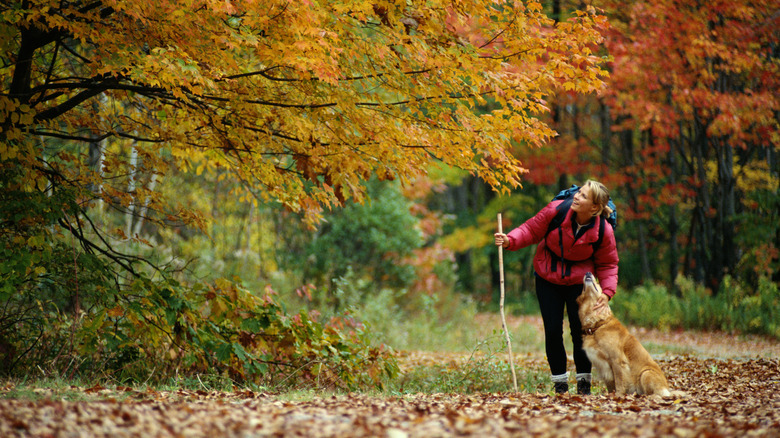What To Know Before Heading Out On A Fun Fall Hike
Fall is considered one of the best seasons of the year to go hiking. This is attributed to many factors, including the milder temperatures and, of course, the dazzling array of colors found on landscapes across much of North America this time of year. There are scenic rivers and lakes across America, as well as U.S. and Canadian National Parks with vibrant fall foliage. There are so many incredible spots, it seems the only challenge to finding the perfect spot for a fall hiking adventure is narrowing down the choices.
Despite the abundance of amazing natural scenery — and in some instances because of it — fall can present some unique challenges for hikers and requires slightly different preparation than hiking at other times of the year. Additionally, while the pleasant weather makes outdoor activities more enjoyable, it can also dictate what you wear and when you should hike. So, in addition to packing the 10 essentials for hiking emergencies, there are a few things you need to know before heading out on a fun fall hike.
How to stay comfortable and safe on a fall hike
Fall typically means cooler temperatures. While these temperatures may seem to be a relief from the summer heat, they can also quickly become unbearably cold if you are not adequately prepared and dressed for it. Knowing what to wear on a fall hike can make all the difference in not just being comfortable, but also staying safe. The key is to dress in layers. Autumn weather also changes frequently. Check the forecast before heading out and be prepared for any unexpected weather conditions. Pack a rain jacket, stocking cap, gloves, or other items to stay comfortable and safe if the weather turns colder or wetter than was expected.
According to Climate Central, fall is the second wettest season in the U.S. So not only should you be prepared with the proper apparel, but you should also watch for slick surfaces, as rainfall coupled with a thick layer of leaves on the ground can make for slippery conditions and obscure some potential hazards such as rocks and roots. If you cross streams or rivers, be sure to plan an alternate route back if your primary route becomes too flooded.
Fall days are also considerably shorter than summer. Check sunrise and sunset times before embarking on a hike. It is also handy to know tricks for telling how much daylight is left, such as measuring the distance between the sun and the horizon. Given that you might spend some time hiking in lowlight or dark conditions, it is advisable to utilize a high-vis, reflective backpack such as the Venture Pal 35L Ultralight Daypack, to be seen more easily by vehicles as well as other hikers.

